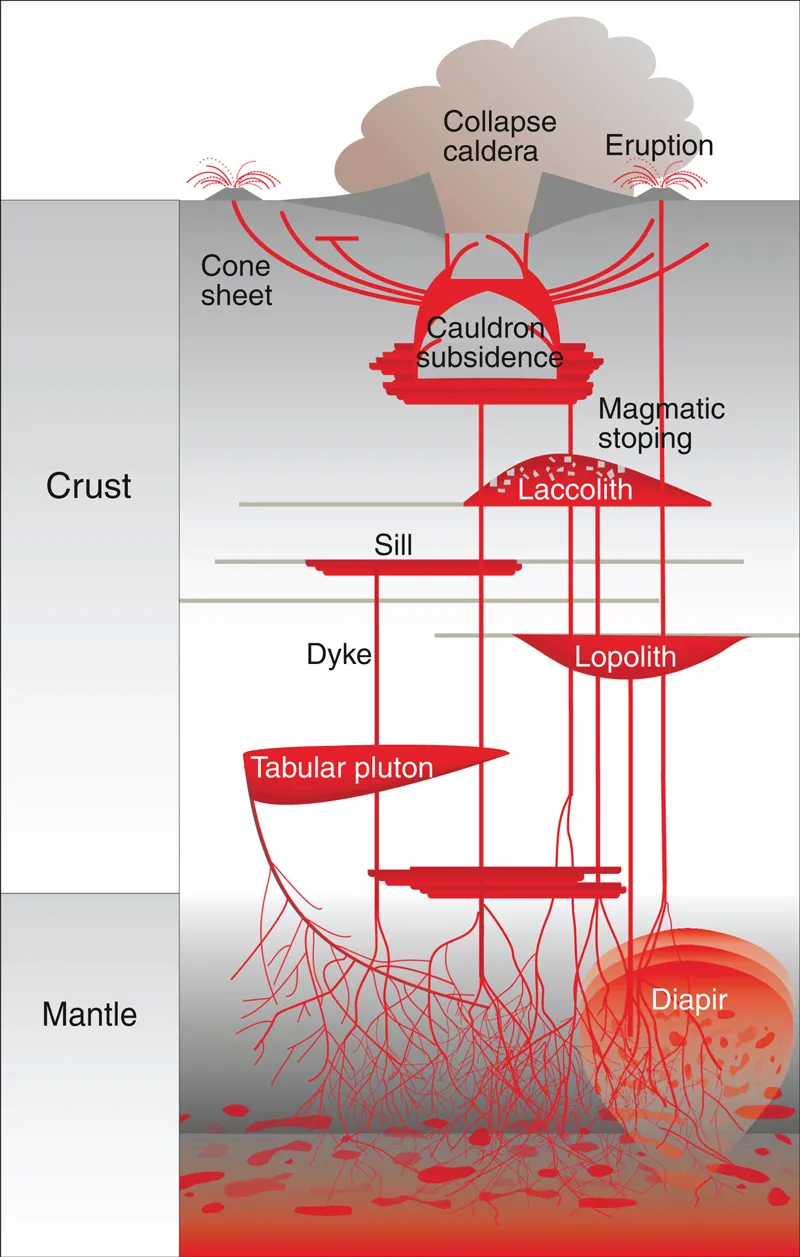
Volcanic and Igneous Plumbing Systems
Understanding Magma Transport, Storage, and Evolution in the Earth's Crust
- 356 pages
- English
- ePUB (mobile friendly)
- Available on iOS & Android
Volcanic and Igneous Plumbing Systems
Understanding Magma Transport, Storage, and Evolution in the Earth's Crust
About this book
Volcanic and Igneous Plumbing Systems: Understanding Magma Transport, Storage, and Evolution in the Earth's Crust synthesizes research from various geoscience disciplines to examine volcanic and igneous plumbing systems (VIPS) in-depth. VIPS comprise a network of magma transport and storage features in the Earth's crust. These features include dykes, sills and larger magma bodies that form the pathway and supply system of magma beneath active volcanoes. Combining basic principles with world-class research and informative illustrations, this unique reference presents a holistic view of each topic covered, including magma transport, magma chambers, tectonics and volcanism.Addressing a variety of approaches to these topics, this book offers researchers and academics in the Earth Science fields, such as geophysics, volcanology and igneous petrology the information they need to apply the information to their own disciplines.- Provides an easily understandable overview of current research on volcanic and igneous plumbing systems- Includes full color illustrations to increase understanding- Covers fundamental information needed to optimize comprehension- Features a field example from world-class research in each chapter, including photographs and maps
Frequently asked questions
- Essential is ideal for learners and professionals who enjoy exploring a wide range of subjects. Access the Essential Library with 800,000+ trusted titles and best-sellers across business, personal growth, and the humanities. Includes unlimited reading time and Standard Read Aloud voice.
- Complete: Perfect for advanced learners and researchers needing full, unrestricted access. Unlock 1.4M+ books across hundreds of subjects, including academic and specialized titles. The Complete Plan also includes advanced features like Premium Read Aloud and Research Assistant.
Please note we cannot support devices running on iOS 13 and Android 7 or earlier. Learn more about using the app.
Information
Introduction to Volcanic and Igneous Plumbing Systems—Developing a Discipline and Common Concepts
Abstract
Keywords
1.1. Introduction

Different types of magma bodies exist, and their formation and shape depend on, for example, the tectonic setting, the amount of magma available and the properties of the magma and the surrounding rocks.
1.2. Developing A Scientific Discipline
Table of contents
- Cover
- Title page
- Table of Contents
- Copyright
- List of Contributors
- Chapter 1: Introduction to Volcanic and Igneous Plumbing Systems—Developing a Discipline and Common Concepts
- Chapter 2: Mechanisms of Magma Transport and Storage in the Lower and Middle Crust—Magma Segregation, Ascent and Emplacement
- Chapter 3: Mechanisms of Magma Transport in the Upper Crust—Dyking
- Chapter 4: Growth of a Volcanic Edifice Through Plumbing System Processes—Volcanic Rift Zones, Magmatic Sheet-Intrusion Swarms and Long-Lived Conduits
- Chapter 5: Storage and Transport of Magma in the Layered Crust—Formation of Sills and Related Flat-Lying Intrusions
- Chapter 6: Pascal’s Principle, a Simple Model to Explain the Emplacement of Laccoliths and Some Mid-crustal Plutons
- Chapter 7: Tectonics and Volcanic and Igneous Plumbing Systems
- Chapter 8: The Petrogenesis of Magmatic Systems: Using Igneous Textures to Understand Magmatic Processes
- Chapter 9: Destroying a Volcanic Edifice—Interactions Between Edifice Instabilities and the Volcanic Plumbing System
- Chapter 10: Volcanic and Igneous Plumbing Systems of Caldera Volcanoes
- Chapter 11: Magma Movements in Volcanic Plumbing Systems and their Associated Ground Deformation and Seismic Patterns
- Chapter 12: Synthesis on the State-of-the-Art and Future Directions in the Research on Volcanic and Igneous Plumbing Systems
- Index